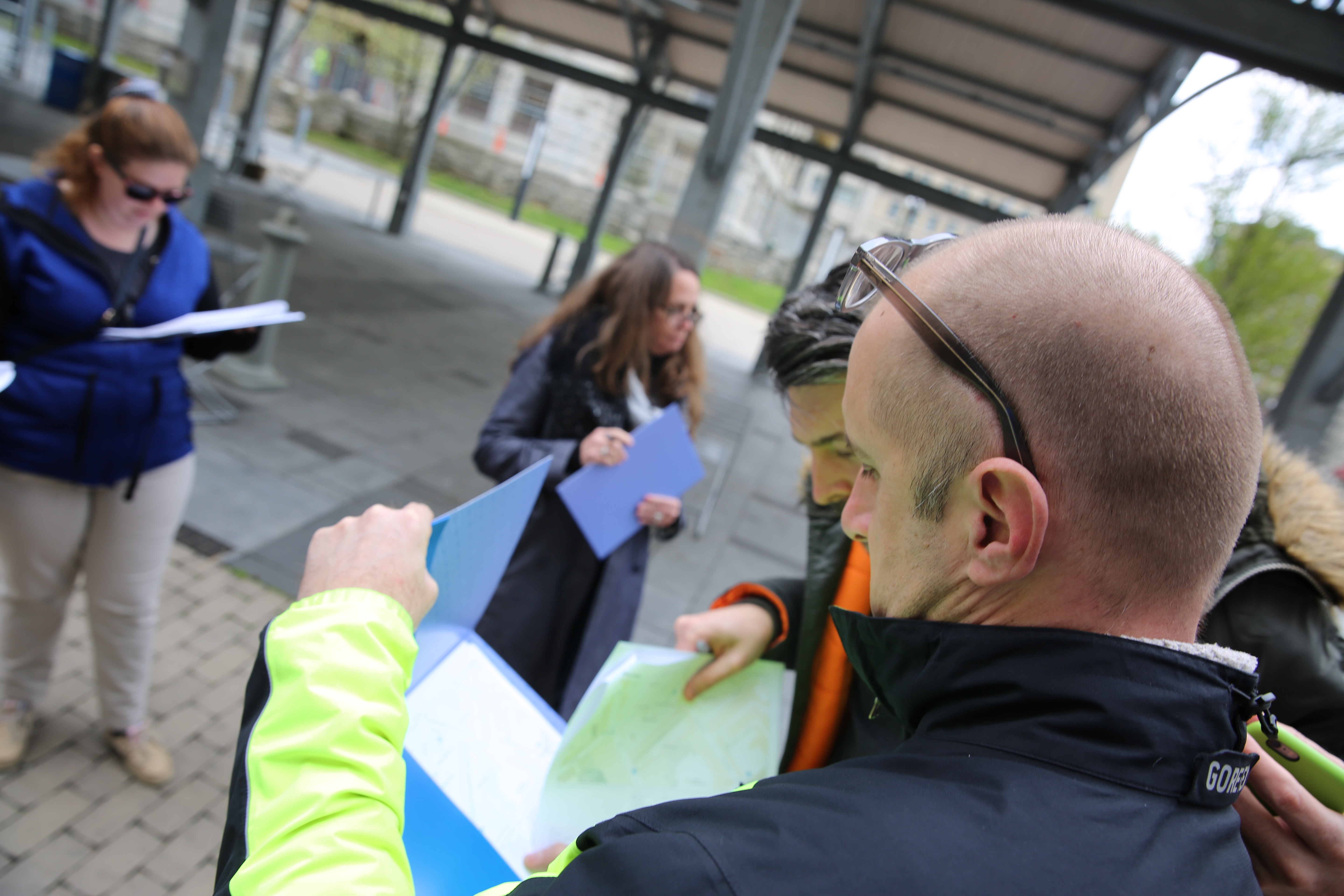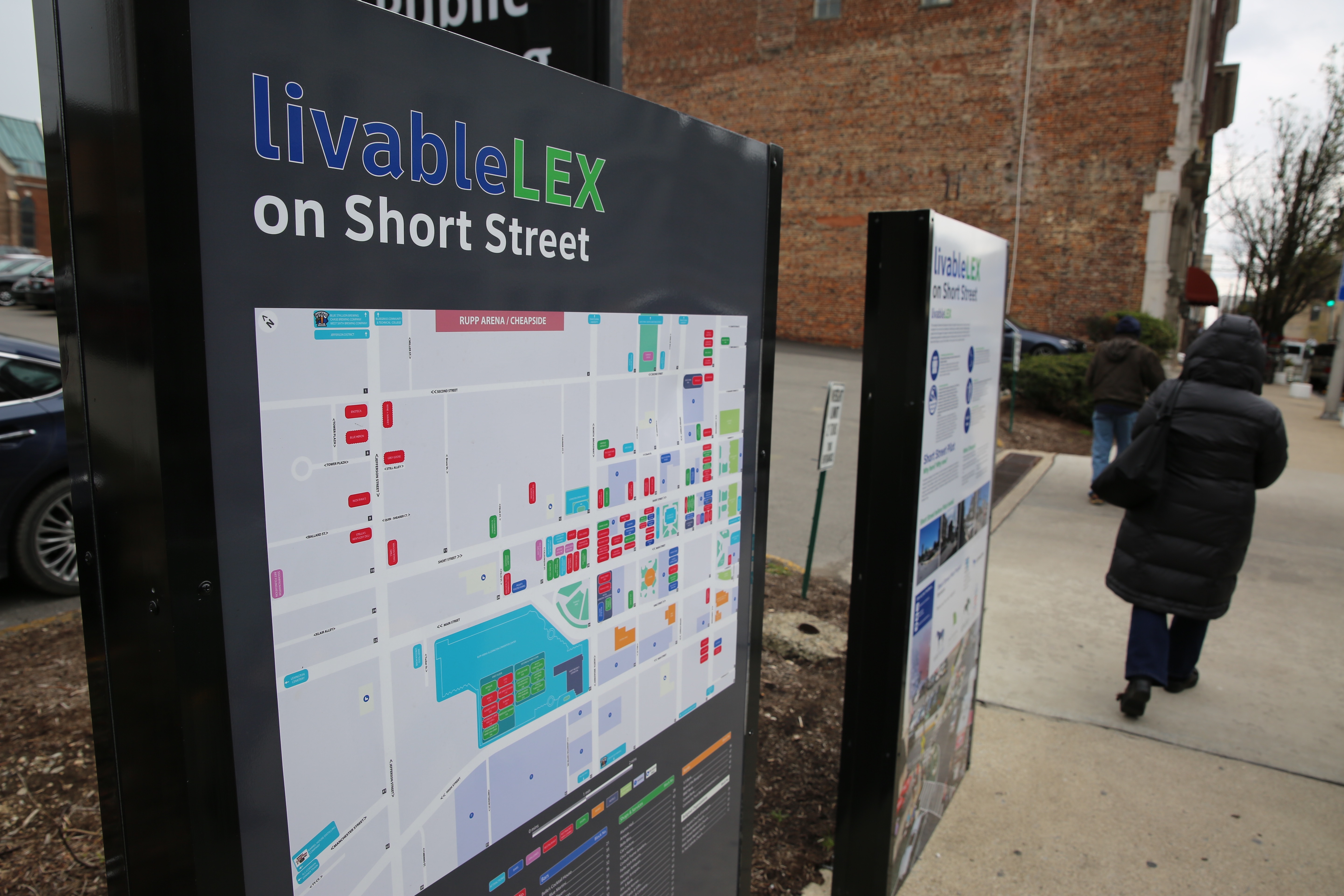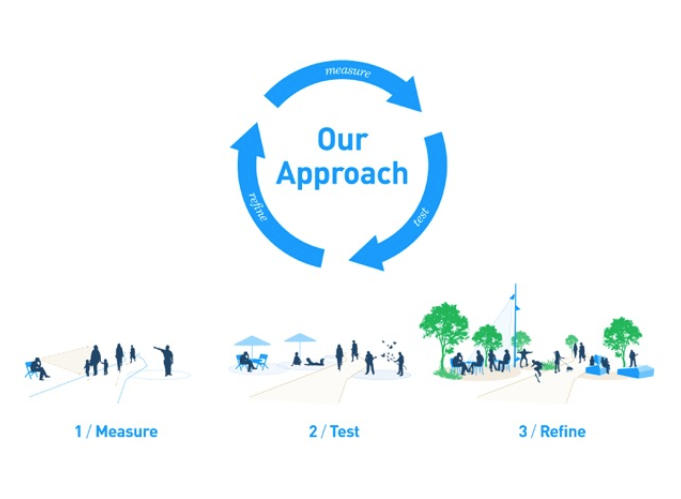
How Knight cities are learning to put people-first design to work
Representatives from four Knight communities and Gehl Architects at the 2016 convening in Lexington. Photos by Rosemary D’Amour.
Angie Martin huddles under an awning in a public square in Lexington, Kentucky, on a cold April morning. She’s tallying the number of pedestrians who walk through the square, making note of the lighting, whether people feel drawn to hang out in the square.
Martin, CEO of the Milledgeville-Baldwin County Chamber of Commerce in Georgia, is taking part in a two-day convening of four Knight communities: Fort Wayne, Indiana; Milledgeville, Georgia; Wichita, Kansas, and the host city, Lexington. The learning exchange will focus on how to develop and measure city projects to improve the experience people have in public spaces.
The gathering is part of Gehl Architects’ people-first design training, which is an interactive series that helps prepare cities for projects that bring people together and make public spaces more vibrant. People-first design is the focal point for Gehl, and the concept is executed much as it sounds: Create cities that consider people first—their scale, senses, behavior and engagement in their surroundings.

Participants in Gehl’s people-first design training measuring public spaces.
Knight’s Community and National Initiatives team has worked with Gehl in the past. An 8 80 Cities project brought representatives from Knight communities to Copenhagen to experience what is often cited as a model for “livable cities.” The convening in Lexington is an attempt to build on the momentum of the Copenhagen trips, which inspired several people-first design projects in cities around the country (including Lexington).
As we walk around the city throughout the two-day conference, we tour people-first design projects and installations that have been implemented throughout downtown Lexington, such as a parking space that has been turned into a micropark. The three visiting teams are experiencing Gehl’s training for the first time, and they have brought along representatives from their respective community foundations, community groups and city government, to learn about what’s worked for Lexington.

Livable Lex on Short Street, a public life project in Lexington.
Build spaces for how humans actually use them
If there isn’t a good understanding of public space, tactical urbanism projects won’t be as effective, said Matthew Lister, head of team at Gehl and one of the leaders at the convening.
“To do this, you need to learn how people actually behave, not how you think they behave,” he said. And the process is simpler than you might think. Essentially, Gehl measures what people are doing when they’re “sticking” around a space.
This idea of “stickiness” carries through Gehl’s training and research. In a public park, are people using the amenities available (i.e. benches, tables)? Are they alone, or in groups? Are they walking, standing, sitting, biking? Do they pass through en route to a major city attraction, or are they enjoying a break from a work day?
On top of counting who moves through a space and how, there are also cultural and place-specific aspects that measuring takes into consideration; for instance, are there adequate protections for pedestrians from vehicles? Does the design of the buildings create a microclimate that generates a wind tunnel, or does it protect people from the elements?
Part of what makes Gehl’s approach unique is the fact that it is rooted in data. The results include information such as an activity mapping survey, which clocks the people walking, biking, sitting and standing in a public space, and a questionnaire about the aesthetics of a public space, like the one Martin was testing.
What kind of life do you want to invite?
When planning projects, urban planners need to think about the kind of life they want to invite in a public space. The key is often less about the sophistication of the design and more about trying things out.
Many cities face a challenge where downtowns have been disinvested in, and resources are spread thin. This makes prioritizing city development projects difficult. But as we’ve seen in Knight cities, small-scale, rapidly implemented public life projects can often have big impact with little investment.
“A lot of times a project goes in and we want it to be successful overnight,” said Julia Day, a project manager at Gehl and facilitator at the convening. “It’s important to let it play out, and if it’s not working, reimagine the approach.”

Gehl’s iterative placemaking approach, which can help limit risk and scale a project for the future. “We’re increasingly realizing the value of a quick pilot,” Lister said.
How to move from plan to reality
Still, an obvious challenge for many cities is implementation, both due to cost and aligning support for a project. Cities at the convening were encouraged to work with their strengths.
“There are projects that we can do now,” said Martin. “I think that Milledgeville is right on the cusp of being able to embrace these low-cost, high-priority items.”

Angie Martin and the team from Milledgeville workshop public life projects.
For Paul “P.J.” Thuringer from the City of Ft. Wayne, the convening brought an opportunity to discuss a riverfront development project in the city, and how to bring the decision-makers together. “It was really helpful to talk about the power metric—thinking about all of the people involved,” he said.
A learning exchange
It’s vital for communities to learn from each other’s successes and failures. The convening in Lexington brought together four cities to learn from one another, to exchange insights, best practices and create pathways for collaboration. The attendees left with strategies that can fundamentally impact their communities for the better.
“We have this great cohort of communities through Knight Foundation that is a set group that we can work with. It’s different than sitting in a webinar in your office,” said Courtney Bengston of the Wichita Community Foundation. “Having the chance to go out into the community and see the projects that Lexington is working on, and to meet with other Knight communities, it’s been amazing.”
Up next, in Akron
“Knight Foundation has 26 diverse communities across the country. While every community is unique, we share similar challenges and opportunities at the community level,” said Lilly Weinberg, director of community foundations at Knight. “We have a tremendous opportunity to use these Knight communities as a learning laboratory – sharing best practices for future community innovation. These exchanges do just that.”
Recent Content
-
Communitiesarticle ·
-
Communitiesarticle ·
-
Communitiesarticle ·


